5 Tips for Implementing Agile Procurement


When we think about agility, we usually picture the complex software development and project management processes that demand major overhauls.
And that’s about right—for software development.
In procurement, the story doesn’t have to be so complicated.
Agile procurement is about leveraging people, data, and tools that you (most likely) already have within your organization.
Just in more intelligent ways: to boost flexibility, responsiveness, and collaboration.
Today, we will walk you through five practical tips on using these existing resources to make your procurement operations more agile.
Let’s jump right into it.
Becoming more agile starts with tapping into data.
Whether it’s from within or outside your organization, the key is ensuring it’s accurate, up-to-date, and easily accessible.
This data holds valuable insights into your procurement processes, supplier performance, market trends, and customer demands.
Armed with these insights, you can make data-driven decisions and swiftly adapt your procurement—exactly what agility demands.
So, where do you find this timely data?
You require robust systems to gather data across all procurement activities.
This could entail integrating procurement software with IoT devices or utilizing cloud platforms for real-time data storage and analysis.
Centralizing your data sources ensures instant access to crucial information.
Once you have real-time data, use advanced analytics tools to glean deeper insights.
For instance, measure key performance indicators (KPIs) relevant to your procurement objectives, such as procurement cycle times, supplier lead times, and inventory turnover rates.
Analyzing these KPIs in real time enables you to identify trends, anticipate issues, and seize opportunities as they arise.
Moreover, don’t overlook the value of historical data.
Though not in real time, it remains invaluable.
For instance, analyzing historical data with predictive analytics models allows you to forecast future demand and optimize inventory levels proactively, mitigating the risk of stockouts or excess inventory.
Why is Amazon, for example, consistently so successful?
Precisely because they use these techniques.
Amazon leverages sophisticated algorithms and machine learning models to analyze historical sales data, customer behaviors, and external factors.
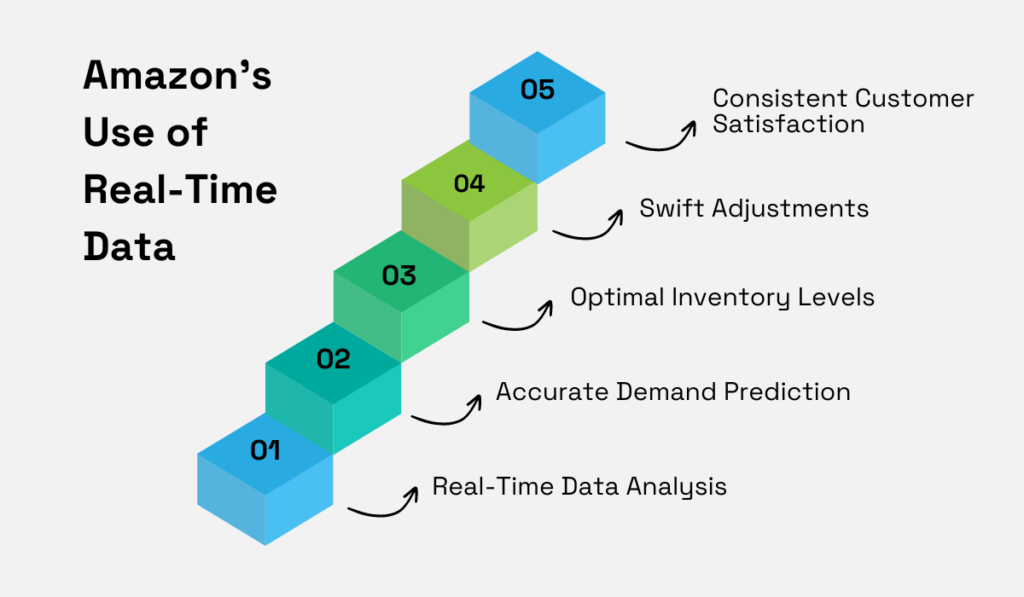
Source: Veridion
This data-driven approach empowers the company to accurately predict future demand, maintain optimal inventory levels, and mitigate the risk of stockouts or overstock situations.
Amazon’s responsive and agile supply chain is another testament to the effectiveness of real-time data analytics.
By identifying trends in real time, Amazon can swiftly adjust inventory levels, optimize distribution routes, and refine procurement strategies to align with changing market conditions.
This agility improves their operational efficiency and ensures that Amazon remains at the forefront of customer satisfaction by consistently meeting demand and exceeding expectations.
Data is something already present in your procurement department. Most likely, you have plenty of it.
So, leverage it.
Combine historical data with real-time data from supplier and procurement performance, as well as current market information.
By doing so, you’ll soon become more agile and ready to adjust your procurement strategies, making them more efficient, with fewer risks, and more adaptable to change.
To achieve agility, you must embrace the right procurement automation tools.
Procurement management software and artificial intelligence (AI) stand out as indispensable tools in making your procurement process agile.
As Graham Wright, former IBM’s Vice President of Procurement Services and current CPO at Kyndryl, aptly describes it, these technologies are like the GPS navigation for your procurement processes, revolutionizing how you navigate through challenges:
“Before we had GPS navigation getting from point A to point B was an arduous process. GPS comes along and all of a sudden, we’ve got an intelligent workflow for getting around town. Intelligent workflows operate the same way in various procurement and accounts payable processes. It’s not just about improving and automating — [intelligent workflows] actually reinforce or reinvent the process flow.”
He rightly points out that intelligent workflows, powered by AI and advanced software, go beyond mere automation.
Yes, automating your current procurement processes, which are full of paperwork and demand too much time, is essential.
In fact, by speeding up these processes and removing some manual tasks, your procurement becomes more agile and lean.
However, this automation also has the power to completely reinforce or reinvent process flows.
Now, you can leverage these tools and the insights they bring to adjust your procurement processes in real time and become more flexible and responsive to change.
Why? Because you have the resources to do it.
One resource that is taking over is artificial intelligence.
AI tools play a pivotal role in identifying both opportunities and risks and accelerating procurement altogether.
For instance, AI systems can analyze supplier data to optimize sourcing strategies and negotiate better deals, or provide timely alerts about impending contract deadlines or potential supplier breaches.
One such tool leading the charge is Veridion, our AI-powered supplier-sourcing enabler.
Veridion offers access to comprehensive data on millions of suppliers worldwide, leveraging AI and machine learning.
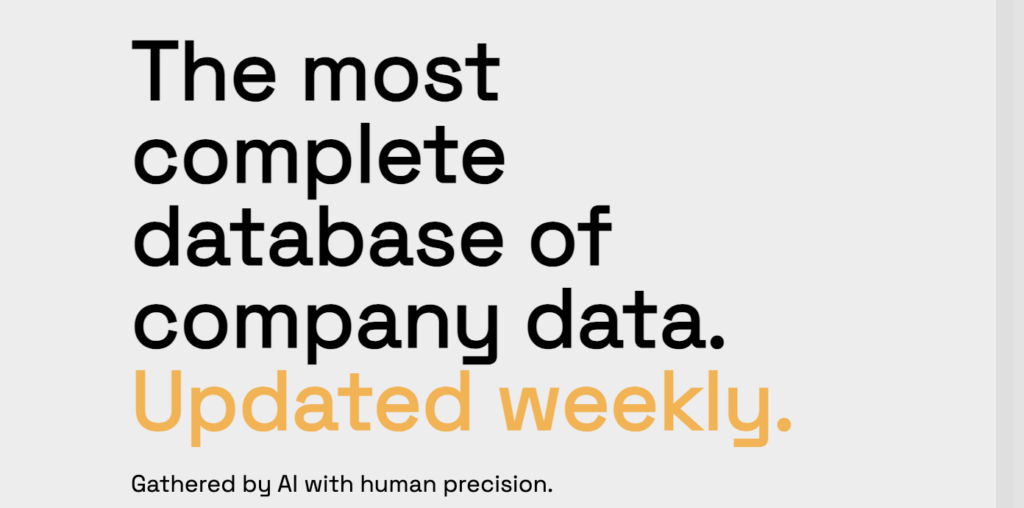
Source: Veridion
By scrapping the Internet for fresh and accurate supplier data, Veridion provides you with a comprehensive list of potential suppliers based on your criteria and shortens your supplier search process from months to days.
In terms of agility, this translates to significant advantages:
On top of all that, Veridion makes you more responsive to change by providing timely alerts on changes in supplier activities.
For example, if a supplier loses a critical certificate, Veridion promptly notifies you, enabling you to swiftly identify alternative suppliers that meet your criteria.
In essence, embracing these innovative technologies not only automates workflows, minimizes mistakes, and saves time but also fosters agility.
It enables responsiveness, adaptability, and effective risk mitigation in procurement processes, which is essential for agile procurement.
Equipping your team with such time-saving technologies gives them valuable time for strategic tasks.
And responsive risk management is one of the most crucial ones.
In procurement, as well as in supply chains, risks are inherent—and various, as we have witnessed in the last few years.
The COVID-19 pandemic, high inflation rates, labor shortages—you name it.
Supplier-related risks, including financial instability, quality lapses, unethical practices, and regulatory non-compliance, further challenge risk management.
And while not every risk can be prevented, being well-prepared for potential risks and having response strategies ready is the key to more agility and resilience.
So, how can you effectively implement responsive risk management?
Start by identifying all potential risks, leveraging data as a crucial asset in this process, as Scott Spencer from Avetta, with 20 years of experience in supply chain risk management, explains:
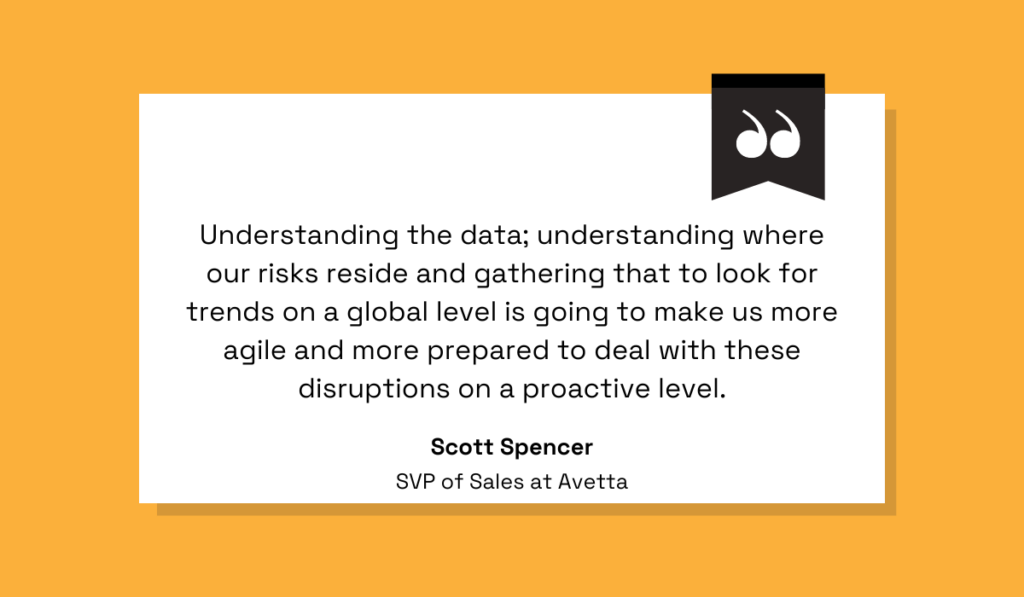
Illustration: Veridion / Quote: Raconteur
While data is undoubtedly the king here, you can take another approach to identify risks.
The example comes from CKW Group, a Swiss energy company that implemented a Lean-Agile Procurement process for sourcing a group intranet solution.
This process emphasizes close collaboration with stakeholders and suppliers through workshops and enables the identification and mitigation of risks even before starting collaboration.
During the 2-day workshops, CKW Group had the opportunity to validate the suppliers’ products, services, cooperation, and competencies by directly engaging with them.
This hands-on approach allowed the team to assess and address social and technical risks on the spot, as well as reduce contractual risks.
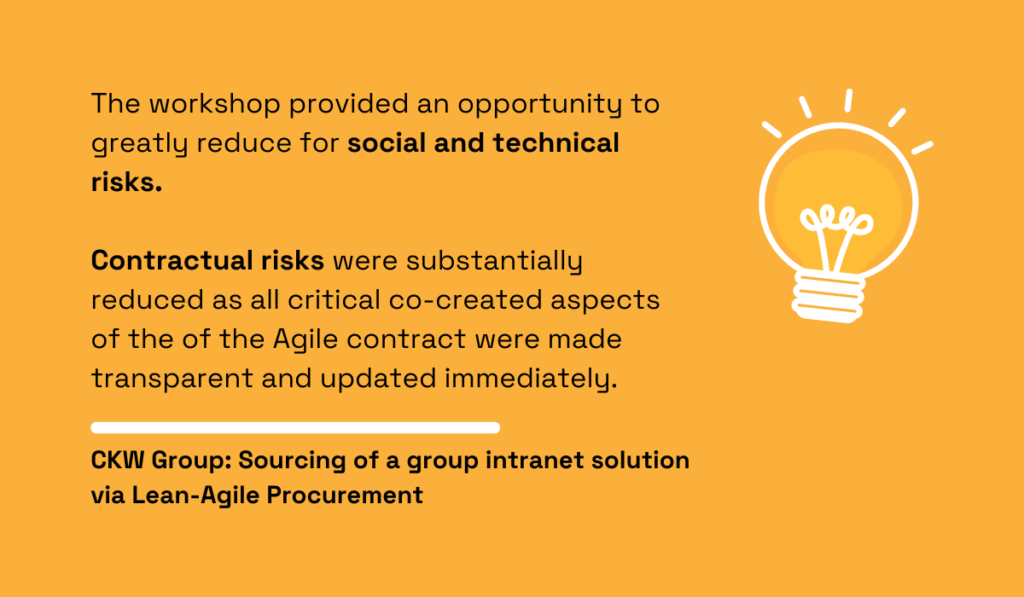
Illustration: Veridion / Data: Business Agility Intitute
In the end, this was one of the reasons why, in just two days, they were able to co-create an agile contract with three vendors.
But this is only the first step.
Once you’ve identified the potential risks, you should:
However, keep in mind that market conditions, regulatory requirements, and business priorities can change over time, leading to new risks or shifting priorities.
So, make sure to regularly review and update your risk management plan to reflect these changes.
Taking such a proactive and data-driven approach to risk management will enhance resilience, agility, and ability to navigate uncertainties in today’s risk-prone business environment.
A vital aspect of agility is cross-functional collaboration, where diverse expertise comes together from the beginning.
This principle is equally important in agile procurement, where teams should include members with skills from various areas, such as:
Such diverse teams will have end-to-end competencies for the entire procurement lifecycle.
In other words, with combined efforts and skills, they will be able to make quick decisions, respond to market changes, and bring innovative solutions to procurement.
Another key principle of agile procurement is delivering early value to all involved parties.
Cross-functional teams achieve this by incorporating a wide range of perspectives and expertise right from the start of the procurement process.
By closely collaborating across functions, teams can identify requirements, constraints, and opportunities early on.
This collaborative approach is particularly important for supplier relationships, as Francois-David Martino, CEO of Danieli China, a supplier of equipment and physical plants to the metal industry, explains:
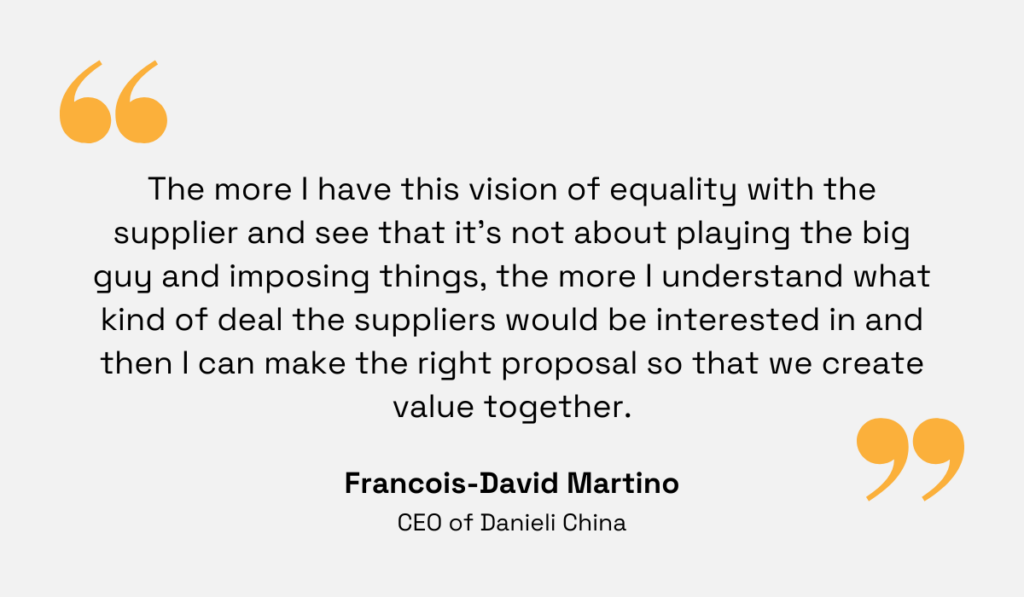
Illustration: Veridion / Quote: CPO Strategy
When the team shares the same values, it enables them to deliver value sooner and more effectively, ensuring that procurement initiatives align with business objectives and stakeholder needs from the outset.
So, make it a point to build teams that value collaboration, information sharing, and making decisions together.
However, it is important to maintain manageable team sizes to uphold agility.
Keeping teams smaller ensures better communication, faster decisions, and yes, more pizza slices per person (just ask Amazon!).
Such organizational structure fosters independent decision-making, quick responses to market dynamics, and innovation, all of which are critical for the success of agile procurement.
Today, we discussed the importance of leveraging data, adopting new technologies, and fostering collaboration across functions to become more agile.
Still, all of these efforts hinge on a culture that embraces change, innovation, and ongoing improvement.
In a world where market conditions can shift in an instant, being able to adapt quickly is key to success.
The teams that are vigilant about emerging trends, ready to tackle challenges head-on, and constantly refining their procurement strategies are the ones that thrive.
That’s resilience.
That’s agility.
That’s what sets you apart in a crowded market.
This culture of continuous improvement also cultivates an atmosphere of innovation within the procurement function.
Empowered teams explore new ideas, experiment with different approaches, and challenge the status quo.
This innovative spirit leads to the development of cutting-edge procurement practices, tools, and technologies, driving efficiency gains and securing a competitive advantage.
On top of that, continuously seeking opportunities for improvement enhances overall procurement performance.
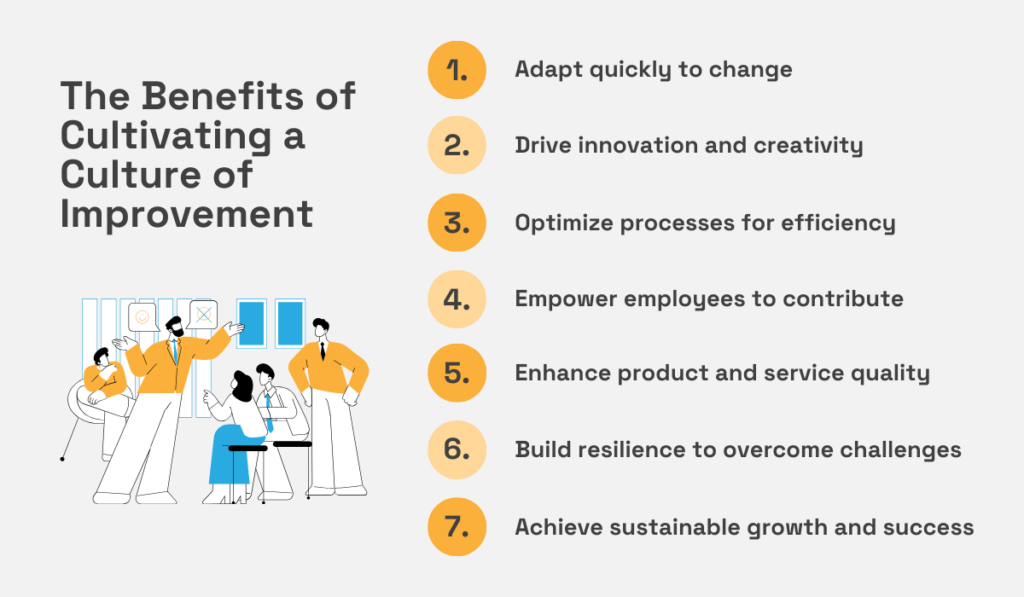
Source: Veridion
Streamlined processes, reduced costs, and higher operational efficiency are just some of the advantages that come from a commitment to ongoing refinement.
So, how do you foster this culture of continuous improvement?
Start with yourself and fully commit to continuously learning and growing, even if it entails encountering setbacks along the way.
After all, agility demands a mindset of experimentation and learning from failures.
On top of that, provide training and tools to your teams, encourage them to find inefficiencies and bottlenecks in processes, and freely communicate them with the rest of the team.
Finally, don’t forget to celebrate successes along the way.
When you embed a culture of continuous improvement into your procurement, you’ll be better equipped to navigate the ever-changing procurement landscape and drive success in the long run.
Today, we outlined five essential tips to enhance agility in your procurement processes.
What’s clear is that achieving agility doesn’t demand anything beyond what modern procurement should already encompass.
From adopting innovative technologies to leveraging real-time data, managing risks, fostering cross-functional collaboration, and embracing a culture of continuous improvement, these practices are not just recommendations but fundamental pillars of successful procurement.
By using the tools, talents, and data already available to you in new ways, you can transform your procurement function into an agile powerhouse, ready to tackle whatever challenges come your way in today’s fast-paced business world.